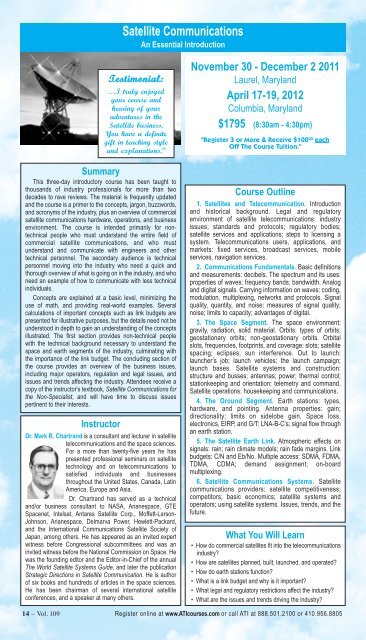Acoustics & Sonar Engineering Radar, Missiles & Defense Systems ...
Acoustics & Sonar Engineering Radar, Missiles & Defense Systems ...
Acoustics & Sonar Engineering Radar, Missiles & Defense Systems ...
Create successful ePaper yourself
Turn your PDF publications into a flip-book with our unique Google optimized e-Paper software.
Summary<br />
This three-day introductory course has been taught to<br />
thousands of industry professionals for more than two<br />
decades to rave reviews. The material is frequently updated<br />
and the course is a primer to the concepts, jargon, buzzwords,<br />
and acronyms of the industry, plus an overview of commercial<br />
satellite communications hardware, operations, and business<br />
environment. The course is intended primarily for nontechnical<br />
people who must understand the entire field of<br />
commercial satellite communications, and who must<br />
understand and communicate with engineers and other<br />
technical personnel. The secondary audience is technical<br />
personnel moving into the industry who need a quick and<br />
thorough overview of what is going on in the industry, and who<br />
need an example of how to communicate with less technical<br />
individuals.<br />
Concepts are explained at a basic level, minimizing the<br />
use of math, and providing real-world examples. Several<br />
calculations of important concepts such as link budgets are<br />
presented for illustrative purposes, but the details need not be<br />
understood in depth to gain an understanding of the concepts<br />
illustrated. The first section provides non-technical people<br />
with the technical background necessary to understand the<br />
space and earth segments of the industry, culminating with<br />
the importance of the link budget. The concluding section of<br />
the course provides an overview of the business issues,<br />
including major operators, regulation and legal issues, and<br />
issues and trends affecting the industry. Attendees receive a<br />
copy of the instructor's textbook, Satellite Communications for<br />
the Non-Specialist, and will have time to discuss issues<br />
pertinent to their interests.<br />
Instructor<br />
Dr. Mark R. Chartrand is a consultant and lecturer in satellite<br />
telecommunications and the space sciences.<br />
For a more than twenty-five years he has<br />
presented professional seminars on satellite<br />
technology and on telecommunications to<br />
satisfied individuals and businesses<br />
throughout the United States, Canada, Latin<br />
America, Europe and Asia.<br />
Dr. Chartrand has served as a technical<br />
and/or business consultant to NASA, Arianespace, GTE<br />
Spacenet, Intelsat, Antares Satellite Corp., Moffett-Larson-<br />
Johnson, Arianespace, Delmarva Power, Hewlett-Packard,<br />
and the International Communications Satellite Society of<br />
Japan, among others. He has appeared as an invited expert<br />
witness before Congressional subcommittees and was an<br />
invited witness before the National Commission on Space. He<br />
was the founding editor and the Editor-in-Chief of the annual<br />
The World Satellite <strong>Systems</strong> Guide, and later the publication<br />
Strategic Directions in Satellite Communication. He is author<br />
of six books and hundreds of articles in the space sciences.<br />
He has been chairman of several international satellite<br />
conferences, and a speaker at many others.<br />
Satellite Communications<br />
An Essential Introduction<br />
Testimonial:<br />
…I truly enjoyed<br />
your course and<br />
hearing of your<br />
adventures in the<br />
Satellite business.<br />
You have a definite<br />
gift in teaching style<br />
and explanations.”<br />
November 30 - December 2 2011<br />
Laurel, Maryland<br />
April 17-19, 2012<br />
Columbia, Maryland<br />
$1795 (8:30am - 4:30pm)<br />
"Register 3 or More & Receive $100 00 each<br />
Off The Course Tuition."<br />
Course Outline<br />
1. Satellites and Telecommunication. Introduction<br />
and historical background. Legal and regulatory<br />
environment of satellite telecommunications: industry<br />
issues; standards and protocols; regulatory bodies;<br />
satellite services and applications; steps to licensing a<br />
system. Telecommunications users, applications, and<br />
markets: fixed services, broadcast services, mobile<br />
services, navigation services.<br />
2. Communications Fundamentals. Basic definitions<br />
and measurements: decibels. The spectrum and its uses:<br />
properties of waves; frequency bands; bandwidth. Analog<br />
and digital signals. Carrying information on waves: coding,<br />
modulation, multiplexing, networks and protocols. Signal<br />
quality, quantity, and noise: measures of signal quality;<br />
noise; limits to capacity; advantages of digital.<br />
3. The Space Segment. The space environment:<br />
gravity, radiation, solid material. Orbits: types of orbits;<br />
geostationary orbits; non-geostationary orbits. Orbital<br />
slots, frequencies, footprints, and coverage: slots; satellite<br />
spacing; eclipses; sun interference. Out to launch:<br />
launcher’s job; launch vehicles; the launch campaign;<br />
launch bases. Satellite systems and construction:<br />
structure and busses; antennas; power; thermal control;<br />
stationkeeping and orientation; telemetry and command.<br />
Satellite operations: housekeeping and communications.<br />
4. The Ground Segment. Earth stations: types,<br />
hardware, and pointing. Antenna properties: gain;<br />
directionality; limits on sidelobe gain. Space loss,<br />
electronics, EIRP, and G/T: LNA-B-C’s; signal flow through<br />
an earth station.<br />
5. The Satellite Earth Link. Atmospheric effects on<br />
signals: rain; rain climate models; rain fade margins. Link<br />
budgets: C/N and Eb/No. Multiple access: SDMA, FDMA,<br />
TDMA, CDMA; demand assignment; on-board<br />
multiplexing.<br />
6. Satellite Communications <strong>Systems</strong>. Satellite<br />
communications providers: satellite competitiveness;<br />
competitors; basic economics; satellite systems and<br />
operators; using satellite systems. Issues, trends, and the<br />
future.<br />
What You Will Learn<br />
• How do commercial satellites fit into the telecommunications<br />
industry?<br />
• How are satellites planned, built, launched, and operated?<br />
• How do earth stations function?<br />
• What is a link budget and why is it important?<br />
• What legal and regulatory restrictions affect the industry?<br />
• What are the issues and trends driving the industry?<br />
14 – Vol. 109 Register online at www.ATIcourses.com or call ATI at 888.501.2100 or 410.956.8805

















